Harvesting
About Harvesting
-
Harvesting Process
-
Types of Harvesting
-
Maturity symptoms and Harvesting period
-
Processing of Sugarcane
-
By Products
Harvesting process
Harvesting Process
Types of Harvesting
Maturity symptoms and Harvesting period
Processing of Sugarcane
By Products
Time of Harvesting
Harvesting of sugarcane at a proper time i.e. peak maturity, by adopting right technique is necessary to realize maximum weight of the millable canes (thus sugar) produced with least possible field losses under the given growing environment. Harvesting either under-aged or over-aged cane with improper method of harvesting leads to loss in cane yield, sugar recovery, poor juice quality and problems in milling due to extraneous matter. |
Therefore, proper harvesting should ensure:
Harvesting: Sugarcane matures in 10-12 month in North India and 18-20 month in South India. Brix value is 16-18 in Dec and Jan at or below 200 C. Different Indicators of harvesting are leaves become yellow, plants stops growing and arrows come out, cane produces metallic sounds, buds swell out and eyes start sprouting. |
Harvesting Schedule
In India harvesting of sugarcane is carried out at 10 to 18 months stage, depending upon the planting time and crop maturity. |
Types of harvesting
Manual Harvesting |
 |
Mechanical Harvesting
Sugarcane is harvested by mechanical harvester which move along the rows of cane removing the leafy tops of the cane and cutting the stalk into short pieces or "billets". Billets are loaded into bins which are towed alongside the harvester. When full, the bins are taken by road or tramway to the sugar mill.The field capacity of mechanical cane harvesters varies with the size (2.5 to 4 ha per day of 8 hours. |
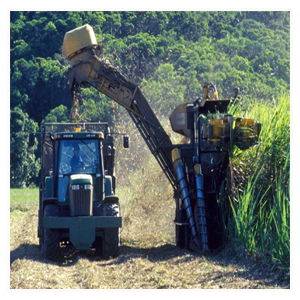 |
Maturity symptoms and Harvesting period
Pre – harvest practices
b. Assessing maturity of crops
|
Harvesting
Harvesting of sugarcane at a proper time i.e., peak maturity, by adopting right technique is necessary to realize maximum weight of the millable canes (thus sugar) produced with least possible field losses under the given growing environment. On the other hand harvesting either under-aged or over-aged cane with improper method of harvesting leads to loss in cane yield, sugar recovery, poor juice quality and problems in milling due to extraneous matter. |
Prevention of Moisture loss in the Harvested cane
Covering the harvested cane with trash and sprinkling with water both under sun and shade reduced the moisture loss and prevented quality deterioration. Among the varieties studied, maximum loss of moisture (5.9%) was recorded by the variety Co 86249 while the varieties Co 94008 and Co 85019 have registered minimum loss of moisture (4.7%). Therefore, proper harvesting should ensure:
|
Purity Percentage = (Sucrose %/HR Brix)100
A cane crop is considered fit for harvesting if it has attained a minimum of 16% sucrose and 85% purity. |
CCS (tons/ha) = [Yield (tons/ha) x Sugar Recovery (%)] /100
Sugar Recovery (%) = [S - 0.4 (B - S)] x 0.73 |
Cane yield
Cane yield = stalk number x single cane weight
Stalk weight depends on
|
General
The integrated production strategies for harvesting the maximum cane yield includes
|
For Ratoon
|
PROCESSING OF SUGARCANE
Collecting the harvested cane
Mature canes are gathered by a combination of manual and mechanical methods. Canes are cut at ground level, its leaves are removed and the top is trimmed off by cutting off the last mature joint. Cane is then placed into large piles and picked up, tied, and transported to a sugar factory. |
Prevention of moisture loss in the harvested cane
Covering the harvested cane with trash and sprinkling with water both under sun and shade reduced the moisture loss and prevented quality deterioration. |
Cleaning and Crushing
Stalks are thoroughly washed and cut when reaching the sugar mill. After the cleaning process, a machine led by a series of rotating knives, shreds the cane into pieces. This is known as "grinding." During grinding, hot water is sprayed on to the sugarcane to dissolve any remaining hard sugar. The smaller pieces of cane are then spread out on a conveyer belt. |
 |
Juicing
The shredded pieces of sugarcane travel on the conveyer belt through a series of heavy-duty rollers, which extract juice from the pulp. The pulp that remains or "bagasse" is dried and used as fuel. The raw juice moves on through the mill to be clarified. |
Clarifying
Carbon dioxide and the milk of a lime are added to the liquid sugar mixture and it is heated to the boiling point, as the process of clarifying begins. As the carbon dioxide travels through the liquid it forms calcium carbonate, which attracts non-sugar debris (fats, gums, and wax) from the juice, and pulls them away from the sugar juice. The juice is then pushed through a series of filters to remove any remaining impurities. |
Evaporation
The clear juice which results from the clarifying process is put under a vacuum, where the juice boils at a low temperature and begins to evaporate. It is heated until it forms into thick, brown syrup. |
Crystallization
By evaporating what little water is left in the sugar syrup, crystallization takes place. Inside a sterilized vacuum pan, pulverized sugar is fed into the pan as the liquid evaporates, causing the formation of crystals. The remaining mixture is a thick mass of large crystals, which is sent to a centrifuge to spin and dry the crystals. The dried product is raw sugar, still inedible. |
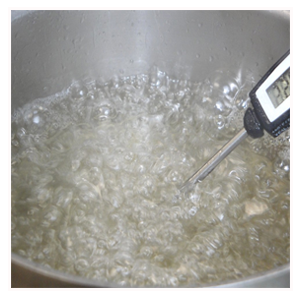 |
Refinery
Raw sugar is transported to a Cane Sugar Refinery for the removal molasses, minerals and other non-sugars, which still contaminate the sugar. This is known as the purification process. Raw sugar is mixed with a solution of sugar and water to loosen the molasses from the outside of the raw sugar crystals, producing a thick matter known as "magma." Large machines then spin the magma, which separate the molasses from the crystals. Crystals are promptly washed, dissolved and filtered to remove impurities. The golden syrup which is produced is then sent through filters to remove the color and water. What's left is concentrated, clear syrup, which is again fed into a vacuum pan. |
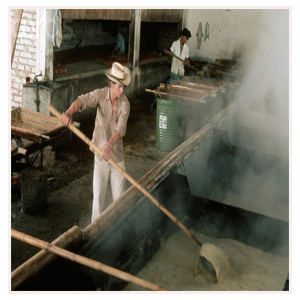 |
Separation and Packaging
Once the final evaporation and drying process is done, screens separate the different sized sugar crystals. Large and small crystals are packaged and shipped, labeled as white, refined sugar. |
NUTRITIONAL VALUE
Sugar, granulated |
Sugars, brown |
Energy- 1,619 kJ (387 kcal) |
Energy- 1,576 kJ (377 kcal) |
By- Products
Raw sugar
|
Sugarcane Juice
|
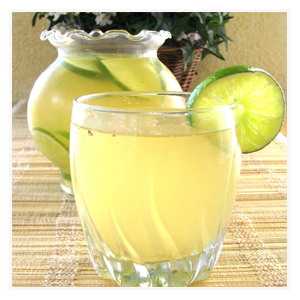 |
Gur or Jaggery
The result of the milling process is pure whole unrefined non-centrifugal cane sugar, called Panela (right). The earliest modern record of Panela is around 3000BC in India, where Panela was known as Gur Jaggery, or more commonly today Gur, or 'poor people’s sugar'. Procedure for Preparation of jaggery: |
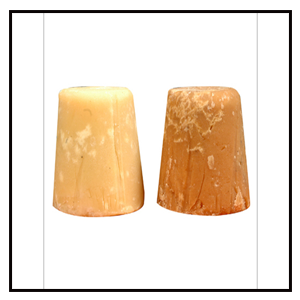 |
Molasses
Molasses is a viscous byproduct of the processing of sugar cane. To make molasses, the sugar cane juice is extracted from the canes, usually by crushing or mashing; it can also be removed by cutting. The juice is boiled to concentrate it, which promotes the crystallization of the sugar. The result of this first boiling and removal of the sugar crystals is first molasses, which has the highest sugar content because comparatively little sugar has been extracted from the source. Second molasses is created from a second boiling and sugar extraction, and has a slight bitter tinge to its taste. |
Bagasse
The bagasse (or the crushed cane fibres), which results from the milling, is used in the boilers for steam production which is used to power the process. The surplus bagasse is used in industry, to produce power, make paper, building materials, as a fuel and even as stock feeds. |
Ethanol
Sugarcane can also be used to make ethanol, a liquid that can be used as an automotive fuel or a gasoline additive. Sugarcane is an excellent feedstock because the biomass of the sugarcane plant is relatively rich in the sugar that can be readily turned into fuel. Brazil is the world’s leading producer of sugarcane ethanol and it is estimated that upward of 40% of Brazil’s transportation energy needs are met by sugar cane ethanol. |
Sugar cane syrup is athick syrup that is created by evaporating the juice extracted from sections of sugar cane. The preparation of this type of cane syrup usually involves boiling the juice for several hours, and making sure to skim the surface of the juice throughout the process. When prepared properly, this approach yields a thick syrup that is extremely sweet, making it ideal for use in both home cooking and the preparation of commercial foods |
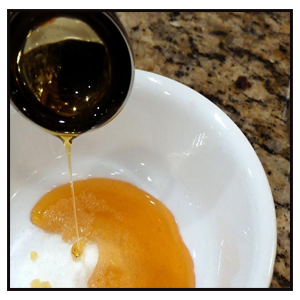 |
Candy
Candy is a type of confectionery mineral composed of relatively large sugar crystals. The candy is formed by allowing a supersaturated solution of sugar and water to crystallize onto a surface suitable for crystal nucleation, such as a string or stick. Heating the water before adding the sugar allows more sugar to dissolve and thus produces larger crystals. Crystals form after 6–7 days. Food coloring may be added to the mixture to produce colored candy. |
Rum
Rum is a distilled beverage made from sugarcane by products such as molasses and sugarcane juice by a process of fermentation and distillation. The distillate, a clear liquid, is then usually aged in oak and other barrels |
Filter cake or mud press
Filter cake or mud press is a chocolate, sticky waste during juice extraction of cane stalks containing 5-15 % protein, calcium and phosphorus; 5-15 % sugar; 10-30% fiber; 10-20% ash and other micronutrients. It is a by-product with high potential as important component of organic fertilizer and animal feed and as source of sugarcane wax and methane (gas for fuel) when process. |
Yeast
Yeasts are complex, protein-rich, living unicellular organisms that have been selected and isolated through research, Saccharomyces cerevisiae to produce baker's yeast. It is normally produced from molasses. About 4 kg of molasses would be required to produce 1 kg of active dry baker's yeast (92 percent dry matter). Yeast is used in bread production at about 1 percent by weight of flour. On a dry matter basis, it contains about 44 percent protein |
Confectionary
Sugar confectionery refers to a large range of food items, commonly known as sweets. Boiled sweets, toffees, marshmallows, and fondant are all examples. |
Sugarcane Tops
Sugarcane tops are a major by-product of the sugarcane industry which is left in the field after harvest and widely used for feeding draught animals or cattle owned by workers on the sugar estates or by the sugar companies. The tops, or leaves from sugarcane are mostly fed to large ruminants and so do not normally constitute a feed resource for small stock. |

